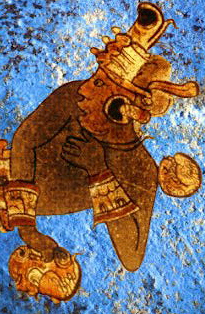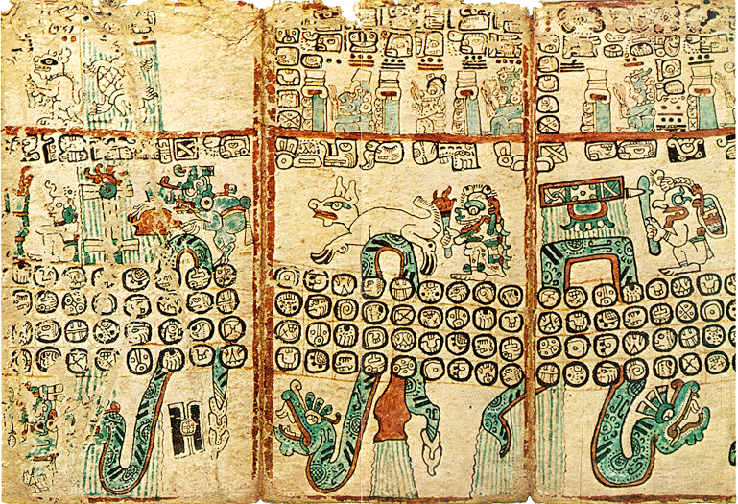Inks
Maya Blue

Distinct and bright Maya Blue background (released by Constantino Reyes into the public domain)
Maya inks are a fascinating subject, and are one of the reasons that the Grolier Codex is said to be in dispute. Maya Blue is unique to Maya manuscripts and has been found and verified on the other three codices, but was not identified on the Grolier Codex. This blue colorant is interesting to researchers because it maintains its bright vibrant color on the codices as well as on walls, potteries, and (it is said) bodies of human sacrifices. It has been a strangely durable pigment that scientists have long studied to determine its makeup and (hopefully) reproduce this color (Fois, Gamba, & Tilocca, 2002). “Despite exposure to acids, alkalis, and chemical solvents, the color of the Maya Blue pigment remains unaltered” (Polette-Niewold, Manciu, Torres, Avlarado Jr., & Chianelli, 2007, p. 1958). Although scientists determined that there were two main ingredients in Maya Blue (indigo, a plant dye still used today in jeans, and palygorskite, a kind of clay), it was also recently discovered that a second colorant was formed via oxidation when the mixture was heated to create the distinct color. Many say that Maya Blue looks like a variety of colors, depending on the light and angle at which you are looking, from the bright blue to a yellowish color, and dehydroindigo, the newly discovered pigment, lends to the yellows tones that can be seen. The fact that this color remains so bright and has stumped researchers and chemists for so long is a testament to the advancements that the Maya made in all sorts of technological areas, including writing and artwork.
Other Colors

Red borders can be seen around the edges of each page (public domain)
Of course the Maya also used other colors for inks, predominantly black and red. Often a red border would be made around the pages, as can be seen on the images shown above. Red was also used in spot colors around the page or to color in certain parts of images and words. Reds were either made from the cochineal (a plant-sucking insect) or hematite (iron ore rust), although it appears that the red in the codices is most often from hematite.
Black was often made from soot from cooking or ritual fires (by scraping off the bottoms of pots) basically carbon mixed with water to make it usable with brushes and pens. Other colors were used sparingly, but the Maya had a surprisingly wide variety of colors from green to pinks. Colors were most often made from organic materials, such as plants, bugs, seashells, tree sap, trees (bark and/or leaves), different types of clays, and minerals. Inks were made by crushing and then combining these source materials with water and sometimes by heating it to combine and create reactions within the materials to heighten color (particularly for the Maya Blue mentioned above).